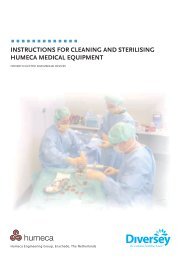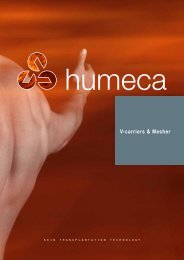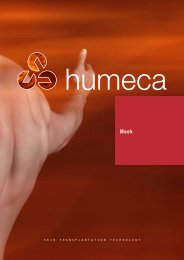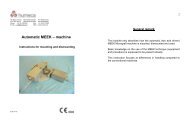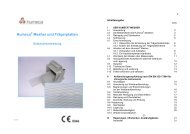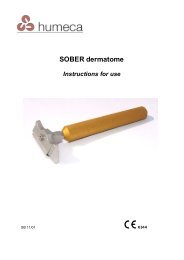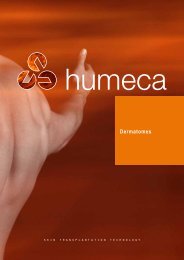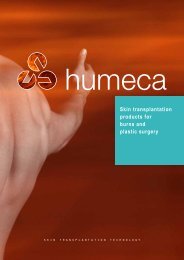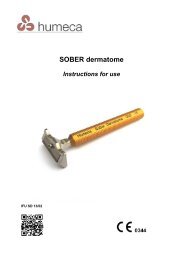You also want an ePaper? Increase the reach of your titles
YUMPU automatically turns print PDFs into web optimized ePapers that Google loves.
<strong>Humeca</strong> <strong>Mesher</strong> <strong>and</strong> V-<strong>carriers</strong><br />
Properties <strong>and</strong> instructions for use<br />
IFU11/02
2<br />
Contents<br />
SECTION I HUMECA ® V-CARRIERS<br />
Page<br />
I-1 Introduction 3<br />
!-2 Working principle 3<br />
I-3 The shape of <strong>Humeca</strong> ® V-<strong>carriers</strong> 5<br />
I-3.1 Groove pattern 5<br />
I-3.2 Connecting grooves 6<br />
I-4 Different types of <strong>Humeca</strong> ® V-<strong>carriers</strong> 7<br />
I-5 Instructions for use 7<br />
I-6 Labelling 8<br />
I-7 Technical data <strong>Humeca</strong> ® V-<strong>carriers</strong> 9<br />
I-8 Storage 10<br />
I-9 Warranty 10<br />
I-10 Ordering <strong>and</strong> delivery of V-<strong>carriers</strong> 10<br />
SECTION II THE HUMECA ® MESHER<br />
Page<br />
II-1 Application 11<br />
II-2 The main parts of the <strong>Humeca</strong> ® mesher 11<br />
II-3 Cleaning <strong>and</strong> sterilization 13<br />
II-4 Lubrication 15<br />
II-5 First use 14<br />
II-5.1 Check carrier adjustment 14<br />
II-5.2 Change carrier adjustment 15<br />
II-6 The procedure of meshing 16<br />
II-6.1 Mounting the mesher after sterilization 16<br />
II-6.2 Meshing 16<br />
II-7 Exchanging the blades 18<br />
II-8 Storage 19<br />
II-9 Warranty 19<br />
II-10 Technical data <strong>Humeca</strong> ® mesher 19<br />
II-11 Ordering <strong>and</strong> delivery mesher <strong>and</strong> spare parts 19<br />
II-12 Trouble shooting 20<br />
Rules, CE-hallmark, responsibilities 21<br />
Supplier 21
3<br />
SECTION I<br />
HUM ECA ® V-CARRIERS<br />
I-1. Introduction<br />
<strong>Humeca</strong> introduces a range of grooved skin graft <strong>carriers</strong>, called ‘V<strong>carriers</strong>’.<br />
The symmetric V-shaped groove pattern of these <strong>carriers</strong><br />
prevents unwanted sideward movement of the graft during cutting.<br />
V-<strong>carriers</strong> are longer than most of the existing ones <strong>and</strong> the groove<br />
pattern connect to each other <strong>and</strong> thus allows to cut extra long graft<br />
stripes. V-<strong>carriers</strong> are compatible with some other existing meshers.<br />
A special type of V-carrier only perforates the graft in order to allow<br />
drainage of fluids <strong>and</strong> preventing haematoma or seroma between the graft<br />
<strong>and</strong> the wound.<br />
Warning: Always pay attention to the presence of very sharp<br />
blades in the <strong>Humeca</strong> mesher! H<strong>and</strong>le them with care to<br />
prevent cutting accidents!<br />
I-2. Working principle of meshing with grooved <strong>carriers</strong><br />
Skin graft meshing is the term used for cutting slits into a sheet graft <strong>and</strong><br />
stretching it open prior to transplantation. To obtain such slits, the graft is<br />
passed through a so-called mesher. There are different types of meshers,<br />
some using grooved <strong>carriers</strong>, others using flat <strong>carriers</strong> <strong>and</strong> in some<br />
meshers no <strong>carriers</strong> are used at all. A well-known type of mesher contains<br />
circular blades that ‘roll’ over a grooved carrier, thus cutting the graft only<br />
at locations where the blades contact the carrier.<br />
This working principle is illustrated in fig. 1 below.<br />
Fig. 1. W orking principle of mesher with grooved <strong>carriers</strong>
4<br />
Fig. 2 shows where the slits in the skin graft will appear as a result of this<br />
principle. As shown, the length of the slits depends on the width of the<br />
upper part of the grooves <strong>and</strong> of the angle of the grooves. The longer the<br />
slits are, the larger the expansion ratio will be.<br />
short slit s<br />
longer slits<br />
Fig. 2. Schematic detail of a grooved carrier <strong>and</strong> the location <strong>and</strong> length of the<br />
slits.<br />
The slits are represented b y the (red) vertical lin es.<br />
Eventually the result is a mesh structure like the one shown below.<br />
Fig. 3. Picture sho wing a meshed p iece of skin graft
I-3. The shape of <strong>Humeca</strong> V-<strong>carriers</strong><br />
5<br />
I-3.1 Groove pattern<br />
<strong>Mesher</strong><br />
Fig. 4.<br />
Conventional skin graft <strong>carriers</strong> have a groove pattern of straight lines<br />
from the left to the right under a certain angle (fig. 4). This pattern<br />
however might cause the graft to distort during cutting in a mesher.<br />
To prevent such distortion, <strong>Humeca</strong> <strong>carriers</strong> have a symmetric V-shaped<br />
groove pattern (fig. 5).<br />
<strong>Mesher</strong><br />
Fig. 5.<br />
Detail of the symmetric V-shap ed<br />
groove pattern of the <strong>Humeca</strong> carrier.<br />
No distortion will take place during<br />
cutting in a mesher
I-3.2 Connecting grooves<br />
In all <strong>Humeca</strong> V-<strong>carriers</strong>, the pattern of the grooves in one carrier<br />
connects to that of the following carrier. In other words, when the<br />
<strong>carriers</strong> are passed to the mesher one after another, even very long<br />
grafts can be processed. Fig. 6 below shows how the first carrier<br />
connects to the second one.<br />
6<br />
First carrier<br />
Second carrier<br />
Fig. 6. Detail sho wing ho w t wo V-<strong>carriers</strong> connect to each other.<br />
The groove pattern continues from one carrier to the other.<br />
.
I-4. Different types of <strong>Humeca</strong> V-<strong>carriers</strong><br />
7<br />
<strong>Humeca</strong> supplies two carrier thicknesses for each type of carrier (type V10<br />
<strong>and</strong> V15) <strong>and</strong> four different expansion ratios.<br />
Thickness<br />
Type V10 <strong>carriers</strong> are compatible with Zimmer ® meshers, while type V15<br />
<strong>carriers</strong> are compatible with Aesculap ® / B.Braun ® meshers. The <strong>Humeca</strong> ®<br />
mesher can be adjusted to accept either V10 or V15 <strong>carriers</strong>.<br />
Expansion ratio<br />
The V-<strong>carriers</strong> are available in expansion ratios 1:1 (only perforation),<br />
1:1.5, 1:2 (only type V10) <strong>and</strong> 1:3. For larger expansions we advise to use<br />
the <strong>Humeca</strong> MEEK Micrograft technique for faster healing <strong>and</strong> better<br />
results.<br />
I-5. Instructions for use<br />
WARNING 1:<br />
Be sure to use the right carrier in the right machine: If the blades of the<br />
mesher do not touch the carrier at all, probably a type V10 carrier was<br />
used in a mesher that was adjusted to fit type V15 <strong>carriers</strong>.<br />
If, on the other h<strong>and</strong>, a carrier cannot be passed through the machine at<br />
all, please remove it immediately (it might damage the mesher blades)<br />
<strong>and</strong> replace it by a type V10 carrier.<br />
WARNING 2:<br />
The <strong>Humeca</strong> V-<strong>carriers</strong> are single-use products. According to the<br />
amendment 2007/47/EC of the Medical Device Directive we want to<br />
point out that there are risks in using these <strong>carriers</strong> more than once.<br />
Small particles of skin grafts might penetrate the grooves <strong>and</strong> edges<br />
where the blades have cut into the carrier. These particles might be very<br />
difficult to remove by conventional cleaning methods.<br />
Also packaging of the <strong>carriers</strong> might be inappropriate to prevent<br />
accidental damage of the sealed pouch that assures sterility. Therefore<br />
<strong>Humeca</strong> will not accept any responsibility for second use of its V-<br />
<strong>carriers</strong>.
8<br />
Please follow the procedure described below for meshing:<br />
- Place the graft on the carrier (preferred is epidermal side down) <strong>and</strong> put<br />
it in the mesher in the direction indicated by the ‘arrow’ of the grooves.<br />
- Push the carrier in the direction of the blades, while at the same time<br />
turning the h<strong>and</strong>le clockwise until the carrier moves forward.<br />
- Now gently keep turning the h<strong>and</strong>le to move the carrier through the<br />
mesher.<br />
- After meshing, use a forceps to remove the graft from the carrier.<br />
- After complete pass, remove the carrier from the mesher <strong>and</strong> apply the<br />
graft to the wound.<br />
NOTE (1):<br />
If during meshing the graft moves with the blades of the mesher, please<br />
use a forceps to remove it from the blades <strong>and</strong> place it on the carrier<br />
again. Be careful not to damage the blades.<br />
NOTE (2):<br />
If the graft length exceeds the length of the carrier, first mesh part of it<br />
on a V-carrier <strong>and</strong> then continue meshing by connecting a second<br />
carrier to the first one. The grooves connect to each other <strong>and</strong> if care is<br />
taken (seam between both <strong>carriers</strong> minimal), the mesh pattern will not<br />
be interrupted.<br />
Another well known method of meshing a long stripe of graft is to fold it<br />
on the carrier double down <strong>and</strong> mesh as usual.<br />
If more grafts have to be meshed, the same carrier may be used several<br />
times. However do not re-sterilize it <strong>and</strong> use it again at another surgery.<br />
Quality <strong>and</strong> cleanness of the product cannot be guaranteed after resterilization.<br />
I-6. Labelling<br />
Fig. 7 explains the meaning of the signs on the label on the package of a<br />
<strong>Humeca</strong> V-carrier. It is important to take notice of the expiry date <strong>and</strong> LOT<br />
number. In case of any complaint, you will have to refer to these data.<br />
Sterility cannot be guaranteed when the package is damaged. Please do<br />
not use the product in such case.
9<br />
Fig. 7 Examp le of labelling of a <strong>Humeca</strong> ® V-carrier<br />
I-7. Technical data <strong>Humeca</strong> ® V-<strong>carriers</strong><br />
<strong>Humeca</strong> ® V-<strong>carriers</strong> are made of high quality medical grade polymer.<br />
The material was chosen for its flexibility, radiation resistance,<br />
translucency <strong>and</strong> hardness.<br />
Dimensions <strong>carriers</strong> (length x width): 280x78.8 mm (11.0x3.1”)<br />
Thickness type V10: 1.0 mm (0.04”).<br />
Thickness type V15: 1.5 mm (0.06”).<br />
Weights:<br />
6.V10-1.0 expansion ratio 1<br />
6.V10-1.5 expansion ratio 1.5<br />
6.V10-2.0 expansion ratio 2<br />
6.V10-3.0 expansion ratio 3<br />
6.V15-1.0 expansion ratio 1<br />
6.V15-1.5 expansion ratio 1.5<br />
6.V15-3.0 expansion ratio 3<br />
18.9 g (0.667 oz)<br />
17.5 g (0.617 oz)<br />
17.4 g (0.614 oz)<br />
17.3 g (0.610 oz)<br />
26.3 g (0.928 oz)<br />
26.8 g (0.945 oz)<br />
25.4 g (0.896 oz)
10<br />
I-8. Storage<br />
When using or storing the V-<strong>carriers</strong>, please take care of the following<br />
atmospheric conditions:<br />
- Ambient temperature 15-45 o C (59-113 o F)<br />
- Relative humidity 35-90%<br />
- Atmospheric pressure 850-1070 hPa<br />
I-9. Warranty<br />
- In case of any complaint or request for replacement, please return the<br />
original package or refer to the LOT number <strong>and</strong> expiry date as<br />
indicated on the label.<br />
- <strong>Humeca</strong> will replace such products free of charge.<br />
- <strong>Humeca</strong> will not guarantee the quality of V-<strong>carriers</strong> that have been resterilized<br />
or have been used after the expiry date.<br />
I-10. Ordering <strong>and</strong> delivery of V-<strong>carriers</strong><br />
The <strong>Humeca</strong> ® V-<strong>carriers</strong> are packed in carton boxes containing 10 pcs.<br />
Ordering numbers are as follows:<br />
For <strong>Humeca</strong> ® <strong>and</strong> Zimmer ® meshers:<br />
6.V10-1.0 expansion ratio 1<br />
6.V10-1.5 expansion ratio 1.5<br />
6.V10-2.0 expansion ratio 2<br />
6.V10-3.0 expansion ratio 3<br />
For <strong>Humeca</strong> ® <strong>and</strong> Aesculap ® / B.Braun ® meshers:<br />
6.V15-1.0 expansion ratio 1<br />
6.V15-1.5 expansion ratio 1.5<br />
6.V15-3.0 expansion ratio 3<br />
<strong>Humeca</strong> supplies the products ex works (EXW) in accordance with<br />
Incoterm 2010.
SECTION II<br />
HUM ECA ® MESHER<br />
11<br />
II-1. Application<br />
The <strong>Humeca</strong> mesher has been designed for meshing <strong>and</strong> perforating<br />
(split) skin <strong>and</strong> other biological tissues<br />
II-2. The main parts of the <strong>Humeca</strong> ® mesher<br />
The dermatome <strong>and</strong> accessories are shown in pictures 8, 9 <strong>and</strong> 10.<br />
Reference is made to the following parts:<br />
1 Base block 7 Disposable skin graft carrier<br />
1a Groove (2x) 8 Gear wheels<br />
2 Bridge 9 Bearing of blades axis (2x)<br />
3 Grip 10 Lubrication hole (2x)<br />
4 Locking screws (2x) 11 Adjustment screws V10/V15<br />
5 Blades axis 12 Transport axis<br />
6 H<strong>and</strong>le<br />
Fig. 8. <strong>Humeca</strong> ® mesher, side view
12<br />
Fig. 9. <strong>Humeca</strong> ® mesher, bridge open<br />
Fig. 10. <strong>Humeca</strong> ® mesher, underside
13<br />
II-3. Cleaning <strong>and</strong> sterilization<br />
Warning:<br />
Always pay attention to the presence of very sharp blades in the<br />
<strong>Humeca</strong> mesher. Remove them before cleaning <strong>and</strong> always h<strong>and</strong>le<br />
them with care to prevent cutting accidents!<br />
The entire <strong>Humeca</strong> mesher can be cleaned <strong>and</strong> steam sterilized.<br />
It is recommended to clean the mesher <strong>and</strong> blades by h<strong>and</strong> from blood<br />
<strong>and</strong> tissue remnants with hot water immediately after use. Afterwards, the<br />
instrument is to be cleaned by conventional procedures for cleaning<br />
surgical instruments.<br />
Most parts of the dermatome are made out of anodised aluminium. The<br />
least damage to this material is observed when neutral cleaning agents<br />
are used in combination with demineralised water. Strong alkaline<br />
cleaning agents (pH>10) will cause visible changes to the surface of the<br />
aluminium like stains <strong>and</strong> colour fading. Hot air drying temperatures ><br />
90 o C should be avoided. Do not use H 2 O 2 (hydrogen peroxide) in the<br />
washing process, a s it will damage the instrument.<br />
A recommended procedure for cleaning <strong>and</strong> sterilization <strong>and</strong> advisory on<br />
cleaning agents to be used is presented in a publication of <strong>Humeca</strong> in<br />
cooperation with Johnson Diversey. It is provided with each dermatome<br />
<strong>and</strong> available on request. You can also download it from the <strong>Humeca</strong><br />
website www.humeca.nl/downloads.<br />
For cleaning <strong>and</strong> sterilization please proceed as follows:<br />
- Remove disposable skin graft carrier from the mesher.<br />
- Loose the two locking screws (4) until they do not come out anymore.<br />
- Put your h<strong>and</strong> in the grip (3) <strong>and</strong> open the bridge (2) carefully.<br />
- Take out the blades axis (5) (hold it at the bearings 9) <strong>and</strong> clean the<br />
spaces between the blades with a soft brush <strong>and</strong> water (particles of skin<br />
or other tissue might have been captured in these spaces). Either put<br />
the axis back in its position in the mesher or put it in the small<br />
sterilization case <strong>Humeca</strong> supplies for that purpose.
14<br />
Warning:<br />
Do not place the blades axis on some hard surface, as this might<br />
seriously damage the blades!<br />
- Put the mesher (bridge opened) in the sterilization container.<br />
- All parts can be sterilized with saturated steam at the common<br />
temperature of 134 o C (273 o F), usually for 5-10 minutes, or at 121 o C<br />
(250 o F) for prolonged exposure time of approx. 20 minutes.<br />
II-4. Lubrication<br />
For long service life of the instrument, it is recommended to put some<br />
drops of surgical oil into the two holes (10) on the top of the bridge (next to<br />
the grip) after washing <strong>and</strong> before sterilization. <strong>Humeca</strong> supplies<br />
STERILIT ® oil for that purpose.<br />
II-5. First use<br />
II-5.1. Check carrier adjustment<br />
The mesher is suitable for different kinds of skin graft <strong>carriers</strong>.<br />
It was adjusted by <strong>Humeca</strong> on request to fit V10- or V15-<strong>carriers</strong>.<br />
If the instrument was adjusted for <strong>Humeca</strong> V10 <strong>carriers</strong>, it is also<br />
compatible with Zimmer ® <strong>carriers</strong>.<br />
If it was adjusted to <strong>Humeca</strong> V15 <strong>carriers</strong> it is also compatible with<br />
Aesculap ® / B.Braun ® <strong>carriers</strong>.<br />
To check the adjustment of the mesher, please proceed as follows:<br />
- Put the mesher on a table with the backside towards you, put your h<strong>and</strong><br />
under the transport axis <strong>and</strong> lift it a little, as shown in fig. 11.<br />
- If you can lift the axis a little (only about 0.5 mm or 0.02”) <strong>and</strong> so the<br />
axis has some play, the mesher is adjusted to <strong>Humeca</strong> ® V-15 <strong>and</strong><br />
Aesculap ® / B.Braun ® <strong>carriers</strong>.<br />
- If there’s no vertical movement in the axis, the mesher is adjusted to<br />
<strong>Humeca</strong> ® V-10 <strong>and</strong> Zimmer ® <strong>carriers</strong>.
15<br />
Fig. 11. Check adjustment of the mesher<br />
II-5.2. Change carrier adjustment<br />
If you want to change the adjustment of mesher afterwards, please<br />
proceed as follows:<br />
A) Change from <strong>Humeca</strong> ® V-15 (<strong>and</strong> Aesculap ® /B.Braun ® ) <strong>carriers</strong><br />
to <strong>Humeca</strong> ® V-10 (<strong>and</strong> Zimmer ® )<strong>carriers</strong>.<br />
Turn both adjustment screws (11) at the bottom of the mesher (shown in<br />
fig. 10) clockwise with the hexagonal L-key (supplied by <strong>Humeca</strong> with<br />
the instrument) until they are complete fixed. Note: turning these screws<br />
might be a little heavy, as they are fixed with glue. Then turn the screws<br />
a quarter turn counter clockwise. Now there will be no, or hardly any<br />
play left in the transport axis <strong>and</strong> the mesher is ready for use with<br />
<strong>Humeca</strong> ® V-10 (<strong>and</strong> Zimmer ® ) <strong>carriers</strong>.
B) Change from <strong>Humeca</strong> ® V-10 (<strong>and</strong> Zimmer ® ) <strong>carriers</strong> to<br />
<strong>Humeca</strong> ® V-15 (<strong>and</strong> Aesculap ® /B.Braun ® ) <strong>carriers</strong>.<br />
16<br />
Loosen both adjustment screws (11) at the bottom of the mesher<br />
(shown in fig. 10) counter clockwise about two turns (it may be a little<br />
heavy). Now there will be some vertical play in the transport axis <strong>and</strong> the<br />
mesher is ready for use with <strong>Humeca</strong> ® V-15 (<strong>and</strong> Aesculap ® /B.Braun ® )<br />
<strong>carriers</strong>.<br />
II-6. The procedure of meshing<br />
II-6.1 Mounting the mesher after sterilization<br />
After sterilization the bridge of the mesher is open <strong>and</strong> the blades axis<br />
might be stored separately. To prepare the mesher for cutting, please<br />
proceed as follows:<br />
- Replace the blades axis at its correct position in the mesher.<br />
- Close the bridge (turn the h<strong>and</strong>le a little if the gearwheels don’t grip)<br />
<strong>and</strong> fix the locking screws (4 in fig. 8) by turning them clockwise until<br />
complete fixation.<br />
- Check proper operation by rotating the h<strong>and</strong>le (6) a few turns. It<br />
should run easily.<br />
II-6.2 Meshing<br />
- Spread the graft, preferably epidermal side down, on the carrier. Be<br />
sure the type of carrier matches with the adjustment of the mesher. In<br />
case of doubt, please check (see section II-5.1).<br />
Warning I:<br />
Using a <strong>Humeca</strong> ® V-15 (or Aesculap ® /B.Braun ® ) carrier in a<br />
mesher that was adjusted for <strong>Humeca</strong> ® V-10 (or Zimmer ® ) <strong>carriers</strong><br />
may seriously damage the blades! Considerable force will be<br />
required to turn the h<strong>and</strong>le. In such a case immediately<br />
counterturn the h<strong>and</strong>le, take out the carrier <strong>and</strong> replace it or readjust<br />
the mesher.
Warning II:<br />
If a <strong>Humeca</strong> ® V-10 (or Zimmer ® ) carrier is used in a mesher that<br />
was adjusted for <strong>Humeca</strong> ® V-15 (or Aesculap ® /B.Braun ® ) <strong>carriers</strong>,<br />
the mesher will not cut properly. This will not damage the<br />
instrument, but probably the graft will not be cut at all.<br />
In such case replace the carrier or re-adjust the mesher.<br />
- Place the carrier on the base block (1 in fig. 8) <strong>and</strong> push it in the<br />
grooves (1a). Some <strong>carriers</strong> might be too small to fit under both<br />
grooves. In that case push it only under one of the grooves.<br />
- Push the carrier forward until it is stuck between the blades axis <strong>and</strong><br />
the transport axis.<br />
- Now turn the h<strong>and</strong>le (4) clockwise while pushing the carrier until the<br />
axes grips it.<br />
- Turn the h<strong>and</strong>le gently clockwise until the carrier completely passed<br />
the mesher. In case the cut graft sticks to the blades, please take it off<br />
from there with a forceps or wipe it off with a gauze <strong>and</strong> press it back<br />
on the carrier.<br />
- After complete pass, remove the carrier from the mesher <strong>and</strong> apply<br />
the graft to the wound.<br />
Note: Carriers can be used more than once during the same surgery.<br />
However, do not re-sterilize the carrier <strong>and</strong> use it again at another<br />
surgery. The quality <strong>and</strong> cleanness of the product cannot be<br />
guaranteed after re-sterilization.<br />
Note: If the graft length exceeds the length of a <strong>Humeca</strong> ® V-carrier, the<br />
excess length of the graft can be placed on a second carrier that is<br />
pressed to connect closely to the first carrier. The grooves of the<br />
two <strong>carriers</strong> connect to each other.<br />
Note: In conventional meshers, differences in carrier thickness might<br />
cause incomplete cuttings <strong>and</strong> excessive pressure on the blades.<br />
As a unique feature, the <strong>Humeca</strong> ® mesher is provided with two<br />
stainless steel springs that overcome such problems. The springs<br />
equalize pressure differences.<br />
17
18<br />
II-7. Exchanging the blades<br />
After frequent use the blades might become blunt <strong>and</strong> should be<br />
replaced. You can replace the whole blades axis or only the blades.<br />
Please consult <strong>Humeca</strong> or your local dealer.<br />
If you want to replace the blades yourself, please read the following<br />
instructions <strong>and</strong> have a look at fig. 12.<br />
- Remove the locking ring from the axis at the opposite side of the<br />
gearwheel (no. 6A in fig. 12). There are special tongs to remove<br />
such locking rings, but you might also do it with a screwdriver (with<br />
each delivery of blades, <strong>Humeca</strong> will add a new locking ring, so<br />
don’t mind if you damage or loose it).<br />
- Remove the bearing ring at that side (no.1 in fig. 12).<br />
Fig. 12. Exploded vi ew drawing of the blades axis<br />
- Loosen the two nuts (no. 4 in fig. 12) carefully with a spanner 16 mm<br />
(0.63”) To prevent the axis from rotation, you have to can fix it with a<br />
second spanner 13 mm (0.51”) on the flat sides in the area between<br />
the gearwheel <strong>and</strong> the blades.<br />
- Now carefully remove the blades from the axis.<br />
- Clean the axis if necessary <strong>and</strong> place new blades.<br />
- Re-assemble the axis in the reverse way.
II-8. Storage<br />
When using or storing the instrument, please take care of the following<br />
atmospheric conditions: ambient temperature 15-45 o C (59-113 o F),<br />
relative humidity 35-90% <strong>and</strong> atmospheric pressure 850-1070 hPa.<br />
II-9. Warranty<br />
A two years warranty applies on the mesher, except for the blades.<br />
This warranty does not include repairs or replacements if:<br />
- the wrong type of carrier was used,<br />
- other than original spare parts were used for repair by user,<br />
- the mesher was used for other applications than the ones mentioned<br />
in this manual.<br />
Warranty includes free of charge repairs if necessary as a result of<br />
trouble / defects that occurred during normal use of the mesher. In case<br />
of trouble please contact your local distributor.<br />
II-10. Technical data <strong>Humeca</strong> ® <strong>Mesher</strong><br />
Material<br />
anodised alum. / St. steel<br />
Size (lxwxh)<br />
220x212x183 mm (8.66x8.35x7.20”)<br />
Total weight<br />
4.3 kg (9.5 lb)<br />
Number of blades 50<br />
Blades diameter / interspacing 36 / 1.5 mm (1.42 / 0.06”)<br />
Gearwheels ratio 1:2.4<br />
Carrier thickness adjustment 1.0 or 1.5 mm (0.04 or 0.06”)<br />
Maximum carrier width 78 mm (3.07”)<br />
Movement of carrier in 1 turn 46 mm (1.81”)<br />
Sterilization container (lxwxh) 277x232x197 mm (10.90x9.13x7.76”)<br />
II-11. Ordering <strong>and</strong> delivery mesher <strong>and</strong> spare parts<br />
For ordering, please refer to the following article numbers:<br />
19<br />
6.HM01<br />
6.KN50/36<br />
6.BLHM01<br />
6.HMAC01<br />
6.HMAC02<br />
<strong>Humeca</strong> ® <strong>Mesher</strong>, complete set<br />
Blades axis with 50 blades<br />
Single blade<br />
Autoclav e case for <strong>Humeca</strong> ® <strong>Mesher</strong><br />
Autoclav e case for blades axis.<br />
<strong>Humeca</strong> delivers the equipment ex works (EXW) in accordance with<br />
Incoterm 2010.
II-12. Trouble shooting<br />
20<br />
Problem Possible cause Solution<br />
Wrong type of carrier used<br />
or mesher not correctl y<br />
adjusted<br />
Check the type of carrier<br />
(V10 or V15) <strong>and</strong> re-adjust<br />
the mesher if needed (section<br />
II-5)<br />
Turning the h<strong>and</strong>l e<br />
requires too much force<br />
Bearings are dr y<br />
Screws at the bottom of<br />
the mesher are fi xed too<br />
tight<br />
Appl y oil (section II-4)<br />
Loosen these screws a little<br />
more (section II-5-B).<br />
Graft is not cut properly<br />
Graft slips over carrier<br />
during cutti ng<br />
The carrier is not moved<br />
through the mesher<br />
while turning the h<strong>and</strong>l e<br />
Graft is cut into<br />
separated stripes; no<br />
slits are cut<br />
The grooves of two<br />
different <strong>carriers</strong> do not<br />
connect to each other<br />
Wrong type of carrier used<br />
(V10 instead of V15) or<br />
mesher not correctly<br />
adjusted<br />
Blades are blunt<br />
Carrier was used too many<br />
times<br />
Bridge not closed pr operly<br />
In case dermal side down:<br />
graft is too thick (fatty layer<br />
present at the dermal side<br />
of the graft)<br />
The bl ades axis turns, but<br />
the blades do not rotate,<br />
because the nuts (no. 4 in<br />
fig. 12) are not fi xed tight<br />
enough.<br />
Carrier was placed in the<br />
mesher upside down (flat<br />
side up)<br />
Two <strong>carriers</strong> of different<br />
expansion ratio were used<br />
The second carrier was put<br />
in the mesher 180 o turned<br />
with r espect to the first<br />
carrier<br />
Check the type of carrier<br />
(V10 or V15) <strong>and</strong> re-adjust<br />
the mesher if needed (section<br />
II-5)<br />
Replace blades or cutting<br />
axis<br />
Replace carrier for a new one<br />
Check <strong>and</strong> cl ose bridge <strong>and</strong><br />
tighten screws<br />
Harvest new, thinner graft<br />
Try to remove fatty layer <strong>and</strong><br />
try again<br />
Put the graft on the carrier<br />
epidermal si de down <strong>and</strong> tr y<br />
again<br />
Tighten the nuts (no. 4 i n fig.<br />
12), usi ng spanners 16 <strong>and</strong><br />
13 mm (0.51 <strong>and</strong> 0.63”), see<br />
section II-7, <strong>and</strong> check blades<br />
on rotation.<br />
Put carrier in the mesher with<br />
the grooved si de up<br />
Replace <strong>carriers</strong> by two<br />
<strong>carriers</strong> of the same<br />
expansion ratio <strong>and</strong> tr y again<br />
Turn the second carrier 180 o<br />
<strong>and</strong> try again.
21<br />
Rules, CE–hallmark, responsibilities<br />
- The management system of <strong>Humeca</strong> for design, production <strong>and</strong> sales<br />
has been certified according to EN ISO 13485:2003.<br />
- According to the European Medical Device Directory 93/42/EEC the<br />
mesher comes under the head of class I products.<br />
- The V-<strong>carriers</strong> come under the head of Class I sterile products.<br />
- The CE-hallmark <strong>and</strong> serial number are indicated on the mesher <strong>and</strong><br />
on the package of each V-carrier.<br />
- Do not use a V-carrier in case the package is damaged.<br />
- Do not use V-<strong>carriers</strong> after the expiry date indicated on the package.<br />
- In case of any complaint or request for replacement, please return the<br />
original package or refer to the LOT number <strong>and</strong> expiry date as<br />
indicated on the package.<br />
- The manufacturer considers being only responsible for the safety <strong>and</strong><br />
performance of the mesher <strong>and</strong> V-<strong>carriers</strong>, if these are used in the<br />
way as described in this manual. For replacements only original spare<br />
parts must be used. Replacements have to be carried out by the<br />
manufacturer or by his authorized local representative. Repairs are<br />
only carried out if the product is carrying the users official repair form.<br />
All repairs carried out will be specified on a delivery note.<br />
Supplier:<br />
<strong>Humeca</strong> BV<br />
P.O. Box 40175 Het Bijvank 251-a<br />
7504 RD Enschede 7544 DB Enschede<br />
The Netherl<strong>and</strong>s<br />
The Netherl<strong>and</strong>s<br />
phone: +31 53 4762619<br />
fax: +31 53 4771905<br />
e-mail: info@humeca.nl<br />
web: www.humeca.nl<br />
<strong>Humeca</strong> is an EN ISO 13485:2003 certified company.<br />
-----------



